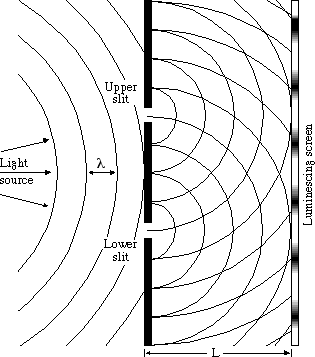51.In a double-slit experiment using a single light source passing through two slits, what is observed at a point on a luminescing screen that is 3 1/6 λ from the upper slit and 4 2/3 λ from the lower slit, as shown in the diagram below?

A. A bright spot
B. A light spot
C. A dim spot
D. A dark spot
The explanation doesnt completely makes sense to me. I got the answer right but i dont think i have the complete idea. It seems like they diffract through but their distances make it so they create a dark spot. I'm not sure how theyre destructive though. It seems like there is more to it ! The correct answer is D.
D is the best answer. The distance of the point on the luminescing screen from the two slits differs by one-and-a-half wavelengths. The waves start in phase when they leave their respective slits, but because they travel different distances, they may or may not be in phase when they meet at the screen. The half-wavelength portion of the difference in their two distances is key, because that defines the two waves as being out of phase at the point where they intersect at the screen. When out of phase, the waves undergo destructive interference, producing a node. When dealing with the interference of light, a node presents itself as a dark spot. The best answer is D.

A. A bright spot
B. A light spot
C. A dim spot
D. A dark spot
The explanation doesnt completely makes sense to me. I got the answer right but i dont think i have the complete idea. It seems like they diffract through but their distances make it so they create a dark spot. I'm not sure how theyre destructive though. It seems like there is more to it ! The correct answer is D.
D is the best answer. The distance of the point on the luminescing screen from the two slits differs by one-and-a-half wavelengths. The waves start in phase when they leave their respective slits, but because they travel different distances, they may or may not be in phase when they meet at the screen. The half-wavelength portion of the difference in their two distances is key, because that defines the two waves as being out of phase at the point where they intersect at the screen. When out of phase, the waves undergo destructive interference, producing a node. When dealing with the interference of light, a node presents itself as a dark spot. The best answer is D.
Last edited:
